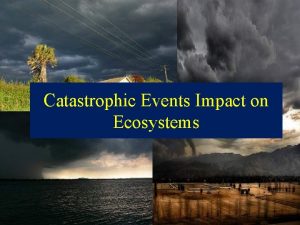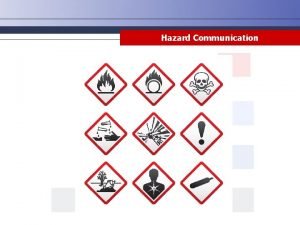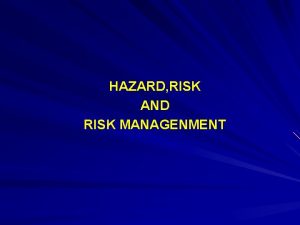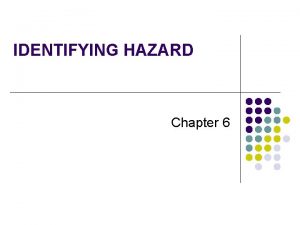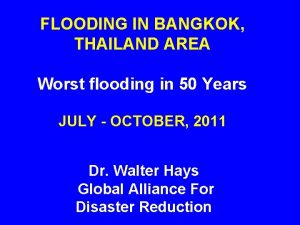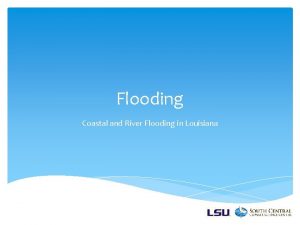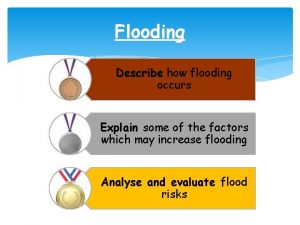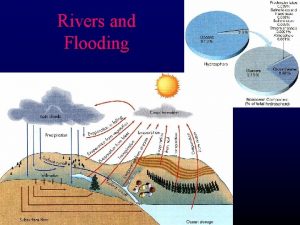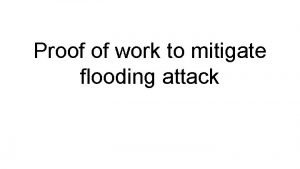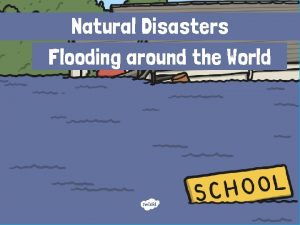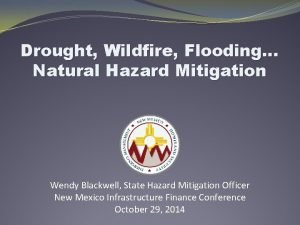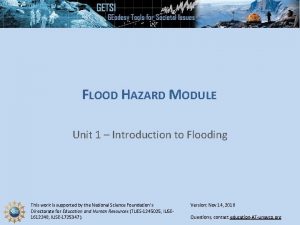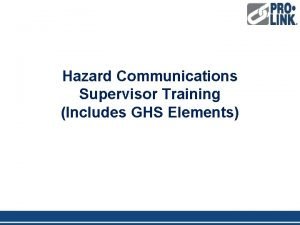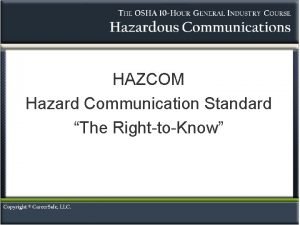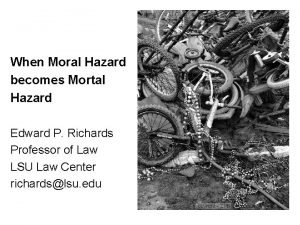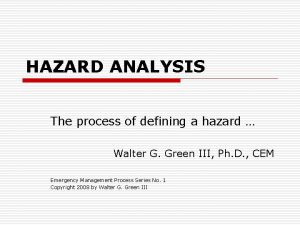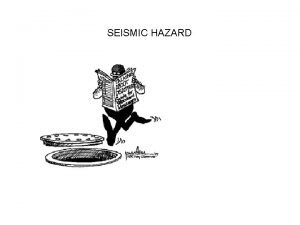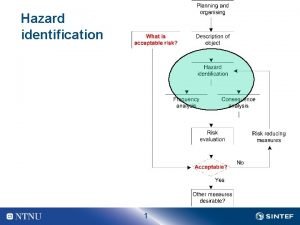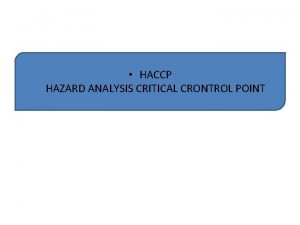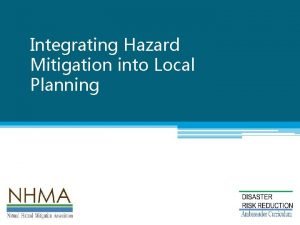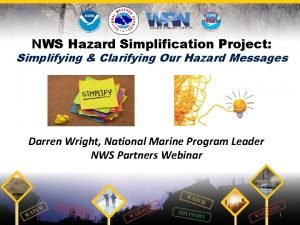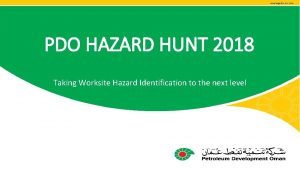THE FLOODING HAZARD What is Flooding Flooding can


























- Slides: 26

THE FLOODING HAZARD What is Flooding ? Flooding can be defined as an overflow expanse of water from natural waterways such as rivers, streams and even oceans onto land that is not usually submerged. A flood is a situation in which water temporarily covers land where it normally doesn’t. Flooding poses great threat to economies of many countries as many losses are incurred to agriculture, housing , public amenities and infrastructure results in losses of billions of dollars each year.

THE DIFFERENT CLASSIFICATIONS OF FLOODING �Flooding can be divided into different categories according to their duration. 1. Slow Onset Floods – usually last for a relatively longer period, it may last for one or more weeks, or even months. This kind of flood last for a long period, it can lead to lose of stock, damage to agricultural products, roads and rail links.

THE DIFFERENT CLASSIFICATIONS OF FLOODING 2. Rapid Onset Floods – last for a relatively shorter period, they usually last for one or two days only. Although this kind of flood lasts for a shorter period, it can cause more damages and pose a greater risk of life and property as people usually have less time to take preventative action during rapid onset floods 3. Flash Floods – may occur within minutes or a few hours after heavy rainfall, tropical storm, failure of dams or releases of ice jams. This causes the greatest damages to society

THE DIFFERENT CLASSIFICATIONS OF FLOODING �Flooding can also be divided into different categories according to their location. 1. Coastal Flooding- occur along coastal areas. When there are hurricanes and tropical storms will produce heavy rains or giant tidal waves created by volcanoes or earthquakes, ocean water may be driven onto the coastal areas and cause coastal floods. Coastal flooding is typically a result of storm surge , wind driven waves and heavy rainfall. Storm surges may overrun barrier islands and push sea water up coastal rivers and inlets, blocking the downstream flow of inland runoff.

THE DIFFERENT CLASSIFICATIONS OF FLOODING 2. River Floods – this is the most common type of flooding. When the actual amount of river flow is larger than the amount the channel can hold, river will overflow its banks and flood the areas alongside the river. This may be caused by snow melt and heavy spring rain as well. Riverine flooding is a function of precipitation levels and water runoff volumes within the watershed of the stream or river.

THE DIFFERENT CLASSIFICATIONS OF FLOODING 3. Urban Floods- in most urban areas , roads are usually paved. With heavy rain the large amount of rain water cannot be absorbed into the ground and leads to urban floods. 4. Estuarine Floods- are the result from sea tidal surges caused by storm force winds or a storm surge from a cyclone.

THE DIFFERENT CLASSIFICATIONS OF FLOODING �Flooding can also be divided into different categories according to their speed. Speed is based on the duration and frequency of precipitation events. �Slow floods – runoff from sustained rainfall or snow melt exceeding the capacity of a river’s channel. �Fast floods – include flash floods resulting from convective precipitation , intense thunderstorms or sudden release from an upstream impoundment.

CAUSES OF FLOODING �The causes of flooding can be classified as physical (natural) or human causes. �PHYSICAL (NATURAL) CAUSES 1. Relief 2. Climatological (Precipiation) 3. Part- Climatological 4. Triggering factors (natural hazards)

CAUSES OF FLOODING (con’t) �HUMAN CAUSES 1. Deforestation 2. Poor farming Practices or Changes in Vegetation 3. Improper landuse and Urbanization 4. Floodplain developments (bridges, dams) 5. Quarrying 6. Pollution (improper waste disposal) 7. River Engineering 8. Human induced climate change

THE NATURAL PROCESS THAT OCCURS WHEN RAIN FALLS �The water is produced by rain is absorbed by the soil in a process known as infiltration or it flows over land enters existing waterways, be it natural rivers and streams, or man made, such as drains. The water which takes the latter route is termed surface runoff. �It is the accumulation of this surface runoff in low lying areas or in areas where drainage is limited or unable to accommodate this runoff that generates flooding. Flooding can also occur when a river overflows its banks due to its water holding capacity becoming overwhelmed.

THE NATURAL PROCESS THAT OCCURS WHEN RAIN FALLS �It is important to note that flooding can result from natural circumstances, traditionally occurring after heavy and or prolonged rainfall in areas of flat relief. �However, it has been man’s activities and the environmental degradation that is believed to have played the biggest part in increasing both the frequency and severity of flooding. This leads to the increased risk of flooding from river systems.

PHYSICAL CAUSES OF FLOODING �Relief - results in the deposition of sediments in river courses from high to low land areas. This effectively reduces the holding capacity of the river in the lowlying regions; a consequence of which is overspill (leading to flooding) during heavy rainfall events.

PHYSICAL CAUSES OF FLOODING �Precipitation – variances in precipitation, especially liquid precipitation, lead to flooding in two ways : 1. Intense or Heavy Rainfall events - results in inundation as the raindrops are unable to infiltrate the soil given the rapid rate of rainfall 2. Prolonged or Extended rainfall – results in inundation as soils become saturated and incapable of absorbing more water. Surface runoff thus increases.

HUMAN CAUSES- MAN’S INFLUENCE �Deforestation – refers to the removal of naturally occurring vegetation from land either through the methods of burning or cutting down of trees. Trees help to stabilize soil, so if they are removed increased erosion and therefore siltation occurs. This in turn lead to possibilities of deluge during heavy rainfall events as river courses easily overflow their banks �Poor Landuse Practices- this involves poor farming practices such as slash and burn agriculture, over cultivation and overgrazing of animals. All these activities culminates in land degradation, increased soil erosion and possibilities of inundation

HUMAN CAUSES- MAN’S INFLUENCE (con’t) �Quarrying – this is the clearing of land for the removal of aggregates (mainly sand gravel) to be utilized in the construction industry. Trees are degraded. This activity increases soil erosion, river sedimentation and flooding events. �Pollution – Large man-made objects that are dumped into rivers lead to clogging of water courses effectively reducing their carrying capacities. Stagnation of rivers, easy overspill and flooding results, with possibilities of flooded rivers being diverted to regions not usually exposed to events of this nature.

HUMAN CAUSES- MAN’S INFLUENCE (con’t) �Urbanisation – this is increased construction of both private and public housing developments as well as commercial buildings. The land is being diverted from its original use for other purposes such as construction of housing settlements, commercial and industrial needs. Permeable soil layers are therefore replaced by impermeable layers of concrete and pitch, increasing surface runoff and possibilities of flash/ prolonged flooding

EFFECTS OF GLOBAL WARMING OF FLOODING �The apparent increased turbulence in climate owing to global warming results in : �Increased frequency and intensity of hurricanes and storms can result in increased extensive flooding events. �Rise in sea level would result in coastal flooding

IMPACTS OF FLOODING �Negative Impacts 1. Loss of Livestock – animals such as cattle, sheep , chicken and ducks not properly tended become victims of sweeping flood waters 2. Loss of Agricultural crops – plants especially those with shallow roots, are easily pummeled to the ground by raging flood waters. 3. Loss of Life- unsuspecting children and adults who underestimate the power and depth of floodwaters are easily claimed as victims.

IMPACTS OF FLOODING �Negative impacts (con’t) 4. Damage to property and infrastructure such as roads, buildings, communications etc 5. Coastal Flooding – coastal regions are flooded by unusually high waves, storm surges or rising sea levels brought about by the global warming phenomenon 6. Health Issues – flooding enhances the prevalence of water borne diseases such as cholera and gastroenteritis 7. Socio-economic issues – millions of dollars are spent to repair damaged property and to compensate flood victims for their agricultural loss. Livelihoods maybe lost during flood events

IMPACTS OF FLOODING �Positive Impacts 1. Deposition of Fertile soil on floodplains nutrient rich particles (productive for agriculture) become suspended in river waters and gets deposited onto floodplains when rivers overflow their banks 2. Inland pollutants are washed out to seas and oceans 3. Replenishment of groundwater supplies, swamps and wetlands – the floodwater increases the amount of water in underground water tables and naturally occurring aquifers. Floodwaters also increase water found in swamps and wetlands thus

MEASURES TO REDUCE/ PREVENT THE FLOODING HAZARD �Actions or Measures taken to deal with the flood problem can be classified into two main categories. They are structural and non structural. �Structural - as the name implies, are those which involve construction of flood defence mechanisms or engineering structures such as storage dams, embarkments, channel improvements, leeves , seawalls etc. They focus on flood abatement or protection of human settlement and activities against the ravages of inundation.

MEASURES TO REDUCE/ PREVENT THE FLOODING HAZARD �Non Structural – involve adjustment to human activity to accommodate the flood hazard. �Flood mitigation measures are divided into three categories , according to Plessis and Viljoen (1999). 1. The control of floodwaters, namely keeping flood water out of developed floodplains. Structural measures are used. 2. Damage reduction to areas of greatest flood damage potential. Non structural measures are used. 3. Measures associated with risk actions by inhabitants of floodplains. Combination of both.

NON- STRUCTURAL MEASURES TO REDUCE/ PREVENT THE FLOODING HAZARD 1. Regular cleaning and maintenance of drains especially in urban areas. This activity would ensure the optimisation and enhance the efficiency of water courses and drainage processes (man-made and natural). 2. Restrict indiscriminate dumping patterns – cease irresponsible dumping of wanted and waste material. The repercussions of indulging in littering in both a small scale or large scale cause severe flood events.

NON- STRUCTURAL MEASURES TO REDUCE/ PREVENT THE FLOODING HAZARD �Reforestation- this involves the replanting of trees and vegetation in areas that lack forest cover. More trees help to stabilize the soil to further prevent soil erosion and increase soil infiltration. �FLOOD PLAIN MANAGEMENT (Dredging / Desilting of Rivers ) – the excess buildup of soil sediments and other materials are removed by the deepening of the riverbed and river channel so that the river can hold more water.

NON- STRUCTURAL MEASURES TO REDUCE/ PREVENT THE FLOODING HAZARD �FLOOD PLAIN REGULATION ( Proper Landuse Planning )– the activities in various flood plain zones can be regulated by grouping these under various priorities. Commercial, industrial and residential developments as well as other activities (like quarrying) are properly organized and regulated in available land space with due consideration of environmental importance. Proper planning guidance is important before constructing any types of buildings. �This is important as new developments could put a strain on already existing drainage system. If precautions are not employed, the natural flow of the river channel could be unintentionally diverted, resulting in flooding in areas that were not traditionally affected by flooding.

NON- STRUCTURAL MEASURES TO REDUCE/ PREVENT THE FLOODING HAZARD �Flood Plain Zoning – is the process of classification of areas liable to floods of different frequencies in the vicinity of a river. These areas are then marked/ demarcated on large scale maps along with close contour intervals and displayed at public places for a wide publicity. �Flood Forecasting- provides advance warning to individuals affected by floods. It tells us as to when the river is going to rise and to what extent. It helps authorities in taking timely rescue and relief measures.
 What impact does a tornado have on an ecosystem
What impact does a tornado have on an ecosystem Trời xanh đây là của chúng ta thể thơ
Trời xanh đây là của chúng ta thể thơ Tư thế ngồi viết
Tư thế ngồi viết Thế nào là giọng cùng tên?
Thế nào là giọng cùng tên? Chó sói
Chó sói Thơ thất ngôn tứ tuyệt đường luật
Thơ thất ngôn tứ tuyệt đường luật Hươu thường đẻ mỗi lứa mấy con
Hươu thường đẻ mỗi lứa mấy con Thế nào là hệ số cao nhất
Thế nào là hệ số cao nhất Diễn thế sinh thái là
Diễn thế sinh thái là đại từ thay thế
đại từ thay thế Vẽ hình chiếu vuông góc của vật thể sau
Vẽ hình chiếu vuông góc của vật thể sau Ng-html
Ng-html Thế nào là mạng điện lắp đặt kiểu nổi
Thế nào là mạng điện lắp đặt kiểu nổi Cách giải mật thư tọa độ
Cách giải mật thư tọa độ Lời thề hippocrates
Lời thề hippocrates Vẽ hình chiếu đứng bằng cạnh của vật thể
Vẽ hình chiếu đứng bằng cạnh của vật thể Tư thế worm breton
Tư thế worm breton Quá trình desamine hóa có thể tạo ra
Quá trình desamine hóa có thể tạo ra Khi nào hổ mẹ dạy hổ con săn mồi
Khi nào hổ mẹ dạy hổ con săn mồi điện thế nghỉ
điện thế nghỉ Các châu lục và đại dương trên thế giới
Các châu lục và đại dương trên thế giới Dot
Dot Nguyên nhân của sự mỏi cơ sinh 8
Nguyên nhân của sự mỏi cơ sinh 8 Bổ thể
Bổ thể Phản ứng thế ankan
Phản ứng thế ankan Thiếu nhi thế giới liên hoan
Thiếu nhi thế giới liên hoan Phép trừ bù
Phép trừ bù
